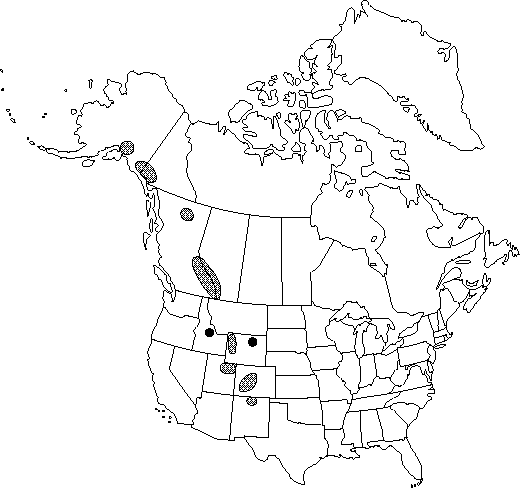Papaver radicatum subsp. kluanense
Novon 5: 294. 1995.
Plants loosely cespitose, to 1.7 dm, mostly shorter, with short, soft, dull, persistent leaf-bases. Leaves to 7 cm; petiole to 2/3 length of leaf; blade gray to blue-green on both surfaces, lanceolate, with 2-3 (-4) pairs of primary lateral lobes, distal pairs closely spaced, proximal often somewhat distant; primary lobes lanceolate, apex acute to obtuse. Inflorescences: scapes erect, white-hispid, often densely so. Flowers to 2 cm diam.; petals yellow, rarely pink tinged or brick-red. Capsules ellipsoid-subglobose to oblong-obconic, to 1.2 cm, strigose, trichomes light-brown. 2n = 42, 56.
Phenology: Flowering Jun–Aug.
Habitat: Dry, rocky alpine ridges
Elevation: 1500-4000 m
Distribution

Alta., B.C., Yukon, Alaska, Colo., Idaho, N.Mex., Utah, Wyo.
Discussion
Plants from the northern part of the range (including the type locality) are taller, with leaf blades 1×-pinnate, larger flowers, and ellipsoid-subglobose capsules, whereas those from the southern part are consistently shorter, with leaf blades 2×-pinnate (more deeply so than in Papaver radicatum subsp. radicatum or subsp. polare), smaller flowers, and oblong-obconic capsules. Because of these differences, D. Löve (1969) maintained P. radicatum subsp. kluanense as distinct from the Utah (and presumably other southern) populations of the Papaver radicatum complex. Nevertheless, we agree with U. Rändel (1975) that the northern and southern populations are linked (in Colorado and Wyoming) by intermediate forms, and hence all are here included within P. radicatum subsp. kluanense.
Selected References
None.
Lower Taxa
"lengthofleaf" is not declared as a valid unit of measurement for this property.